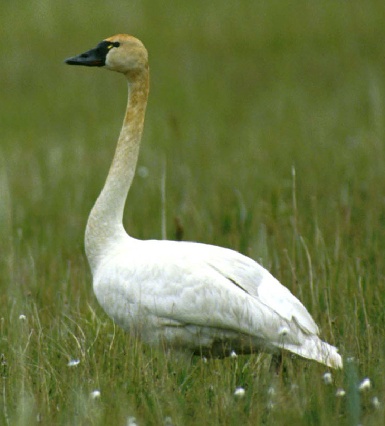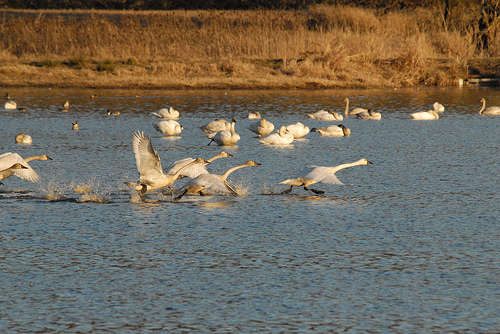
John and Karen Hollingsworth, US Fish and Wildlife Service, license: public domain

TUNDRA SWAN
-migrates between the Canadian Arctic or Alaska and winter grounds in the United States. DESCRIPTION
-flies 6 000 km twice a year
-once called the "whistling swan" because of the sound made by the bird's wings in flight.
-population about 140 000
-types of swans found in Canada : Tundra Swans, Trumpeter Swans and Mute Swans
-Tundra Swans are the most common.
-scientific name cygnus columbianus
-black beak with a small yellow patch in front of their eyes
-feathers on neck and head have a reddish tinge (when feeding in iron-rich areas)
-average male weighs 7.5 kg. and can measure 1.3 m from bill to tail
-adult female nearly the same size but weighs less, about 6.3 kg.
-adults moult (shed feathers) during August
-unable to fly for several weeks till new wing feathers grow
-young are grey, pinkish beaks with black tips, pink legs and feet
-takes about two years to look like the adult
HABITS
-float on the water while sleeping
-dart across surface of water, beating wings to take flight
-each pair has a large nesting territory
-early September they fly to larger lakes that do not freeze yet
-spend a few weeks feeding before migrating south to United States for the winter
-form flocks with other swans for the long migration
-gather in huge flocks at winter grounds

HABITAT and RANGE
-summer on the tundra of the Canadian Arctic and Alaska
-build nests and raise young near shallow pools, lakes or rivers
-two populations of Tundra Swans - eastern population and western population
-eastern population nest from Alaska to Baffin Island
-western population nest in northwestern Alaska
-eastern population winters on the Atlantic coast of the U.S.
-western population winters mainly in California.
-migrate 6 000 km (3725 miles) between these areas twice a year